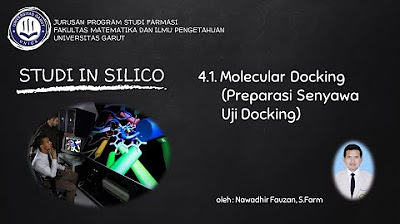Penentuan ADMET Banyak Senyawa Obat dan Senyawa Baru Aktif
Summary
TLDRThis video tutorial explains the process of predicting the properties of chemical compounds using computational tools. It guides viewers through steps such as generating molecular structures, minimizing energy, and predicting properties using online platforms like PKC SM. The video covers the use of tools like Jenderal, 3D structure conversion, and energy calculation, as well as interpreting data such as molecular permeability and absorption. It emphasizes the importance of practice and familiarization with the software to successfully predict and analyze chemical compound behaviors.
Takeaways
- 😀 The process begins with entering molecular data and predicting compounds using software tools like Jenderal and PKC.
- 😀 You need to visualize molecules in 3D format to minimize energy and check for stability before proceeding.
- 😀 Once you have the molecular structure, you save it in different formats (e.g., chem3d, sdf, etc.) for further analysis.
- 😀 Molecular structures can be saved as XML files, which can later be opened and edited using text editors or specific molecular software.
- 😀 PKC software is essential for predicting and analyzing molecular properties based on input data, especially for testing permeability and absorption rates.
- 😀 You should use a translation tool (e.g., Kaktus.com) to convert molecular data into standard formats like SD or SDF files for analysis.
- 😀 After converting data, uploading to platforms like PKC allows you to check the molecular properties such as absorption and permeability.
- 😀 The use of Smile codes for molecular structures is important for ensuring the correct structure data is inputted and analyzed.
- 😀 Data interpretation can include assessing molecular permeability (e.g., Caco-2 permeability) and absorption potential for practical applications.
- 😀 When analyzing data, it's important to adjust visual settings (like grid sizes) in software to make sure all data is legible and accessible for further research.
Q & A
What is the primary focus of the script?
-The script primarily focuses on predicting molecular structures using a software tool, including the process of converting chemical data into different formats, visualizing 3D structures, and analyzing energy minimization.
How does the script suggest predicting molecular structures?
-The script outlines the use of a software called 'Jenderal' to input molecular data, followed by energy minimization steps and further analysis with PKC-SM for structure prediction.
What software is mentioned in the script for predicting molecular structures?
-The script mentions the software 'Jenderal' for inputting chemical data, and PKC-SM (University of Melbourne) for predicting molecular structures and analyzing their properties.
How does the script suggest handling 3D molecular structures?
-The script advises visualizing molecular structures in 3D using 'Chem3D' software, minimizing their energy, and saving them in different formats like chem3d XSM or SDF before analysis.
What is the purpose of energy minimization in the process?
-Energy minimization is used to find the most stable configuration of the molecular structure by reducing the system's energy. This is an important step before performing further analysis and prediction.
What does the script recommend for saving the molecular data?
-The script suggests saving the molecular data in different formats such as chem3d XSM for 3D structures and SDF files for further analysis. These files can be used for further processing in software tools.
What is the significance of the 'PKC-SM' tool mentioned?
-PKC-SM is a tool used for predicting molecular properties based on the inputted chemical structure. It helps analyze parameters such as permeability, absorption, and energy minimization.
How does the script explain the process of interpreting PKC-SM results?
-The script explains that PKC-SM results can be interpreted using the provided theoretical data, such as the Caco-2 permeability value, which helps determine the molecular absorption and permeability properties.
What does the script say about handling files in the process?
-The script emphasizes the importance of correctly saving and opening files in formats like SDF and SMILES to ensure compatibility with different software tools, such as PKC-SM for structure prediction and analysis.
What does the script suggest if the molecular data is not correctly recognized?
-If the molecular data is not recognized, the script suggests adjusting the SMILES code, ensuring the correct file format, and retrying the process to avoid errors in the prediction steps.
Outlines

This section is available to paid users only. Please upgrade to access this part.
Upgrade NowMindmap

This section is available to paid users only. Please upgrade to access this part.
Upgrade NowKeywords

This section is available to paid users only. Please upgrade to access this part.
Upgrade NowHighlights

This section is available to paid users only. Please upgrade to access this part.
Upgrade NowTranscripts

This section is available to paid users only. Please upgrade to access this part.
Upgrade NowBrowse More Related Video

Analisis Kemiripan Obat, Farmakokimia, Fisikokimia, dan Toksisitas Senyawa Alami Kandidat Obat

Elements, Mixtures and Compounds - Iron and Sulphur

UNSUR SENYAWA DAN CAMPURAN | KLASIFIKASI MATERI

Tahapan Virtual Screening untuk Mencari Kandidat Obat berbasis Bioinformatika

4.1. Molecular Docking (Preparasi Senyawa Uji Docking)

CHIMICA FACILE 3 - I Composti e le reazioni chimiche
5.0 / 5 (0 votes)